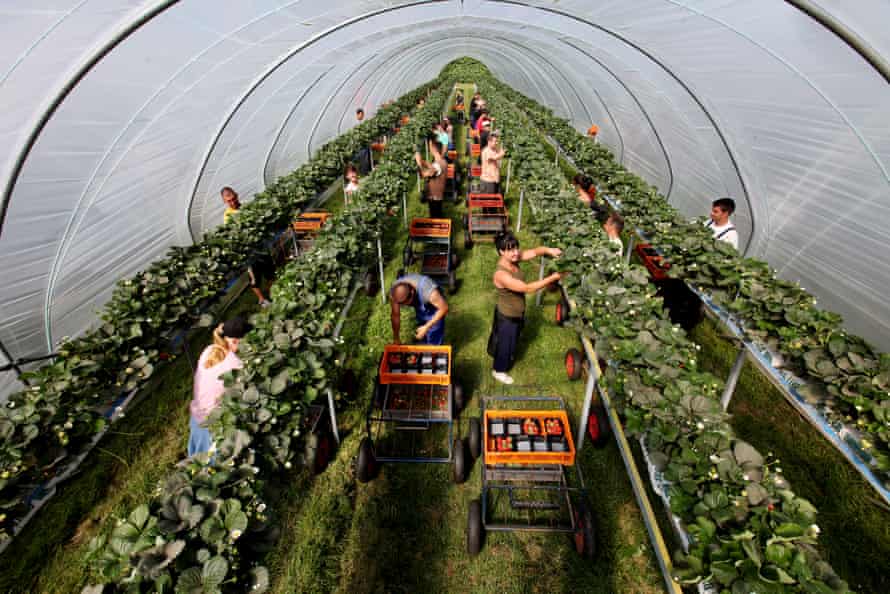It would be easy to dismiss it as a marketing gimmick. A strawberry called Ace, announced on the eve of Wimbledon – surely, you cannot be serious? But the academics and strawberry breeders of the East Malling research institute are not given to cheap slogans. Malling Ace is a super strawberry that is creating more excitement in the world of horticulture than even the possibility of another Andy Murray title.
“The Ace name sort of indicates what we felt about it – it really, really does excel,” said Adam Whitehouse, who led the Malling Ace project. “It’s a new variety that has been fast-tracked through our system because it really did stand out and it caused a lot of excitement at such an early stage.”
Growers are falling over themselves to sign up to the new variety, and commercial nurseries are doing their best to get as many Malling Ace plants available as soon as possible.
The excitement is there because Whitehouse and his colleagues at NIAB EMR in East Malling, Kent – Britain’s pre-eminent horticultural research centre – have cracked a conundrum that should mean that shoppers can find tasty, plump strawberries for most of the year, not just around Wimbledon time.
Strawberries come in two varieties. June-bearers are the classic berries found at the All England Club that come from plants which fruit in the early summer and are the tastiest, reddest and juiciest.
But the short six- to eight-week cropping season of June-bearers has spurred horticulturalists to find ways to extend the season. In the 1970s, Californian researchers discovered an alternative that bore fruit twice a season or more and, for the last 50 years, these ever-bearers have been the strawberries most commonly found in supermarkets from July onwards: reliable, solid – and often disappointingly dull.
The Malling Ace promises to be the first ever-bearer with the tastiness of its June counterparts – “the stuff of dreams” and “not a step change, but a leap change,” according to the research institute’s operations director, Ross Newham.
The process of creating the Malling Ace began more than 250 years ago. As befits the queen of summer fruits, modern strawberries originated in the gardens of Versailles. Antoine Nicolas Duchesne, botanist to Louis XV, experimented with wild strawberries and discovered he could cross-pollinate plants to breed new varieties, sparking a revolution in horticulture that informed Darwin’s discovery of natural selection.

Whitehouse and his colleagues in East Malling use a method derived from Duchesne’s experiments, brushing pollen from one plant on to another and making painstaking observations about the results. The process usually takes about eight years but the Ace has been brought forward because of its success.
“I selected it in 2015,” Whitehouse said. “It was one of about 13,000 seedlings we were looking at that year. We normally try to whittle it down to about 1% – the elite. But this one really stood out. We trialled it and it really caught the attention of everyone who saw it.”
Taste and colour are very important but there are other less obvious criteria – disease resistance, glossiness and yield are among the dozens of factors that East Malling’s researchers examine. Another is “plant architecture” – how the branches grow – which makes a big difference to how easy it is to pick the fruit.
That remains a significant issue for strawberry growers focusing on this year’s crop. They are concerned that they will again not have enough fruitpickers, according to Nick Marston, the chairman of British Summer Fruits. “I think there will be a greater level of shortages. I don’t think that we’re going to see large-scale crops rotting in the fields but I think we will see some crop losses where growers just can’t get enough people.”
Growers rely on eastern European workers to pick their crops, and many have been put off by stricter post-Brexit visa rules. Last year, the government allowed 10,000 seasonal worker visas, a figure which has risen to 30,000 this year – still far short of the 70,000 required.
Farms with early crops are less likely to be affected, Marston said, because foreign workers often prefer to earn up to their income tax personal allowance of GBP10,500 then return home rather than stay and deal with the red tape of tax.
“There is a nervousness because as the summer goes on, people start to go home,” he said. It’s more acute in Scotland because it’s further to travel and their season starts later.”
Getting punnets of Malling Ace on to supermarket shelves will have to wait until next year, because nurseries need to grow more plants to make a large-scale crop.
Will Roberts, who oversees intellectual property issues for NIAB EMR, said 90% of growers and plant nurseries working with East Malling have applied for licences to grow Malling Ace – an unprecedented number. “We’re now at the final stage of development and the plants are now being multiplied at plant nurseries,” he said. “So I think the average consumer will be able to see Malling Ace in small quantities available early next summer.”
For Whitehouse, even though Malling Ace is a major advance, there is still plenty of work left to do. At the moment, one punnet of strawberries can seem much like another. Shoppers may eventually distinguish between varieties and debate their merits, as aficionados of mangoes have done with the Kesar and Alphonso in India.
“The holy grail of ever-bearers is continuous production,” Whitehouse said. “Even though ever-bearers do have perpetual flowering, they can go into dips and troughs, and that can change from season to season. For me as a breeder, the next step is to give people the chance to buy a strawberry, and if they like it, they can buy it again next week.”